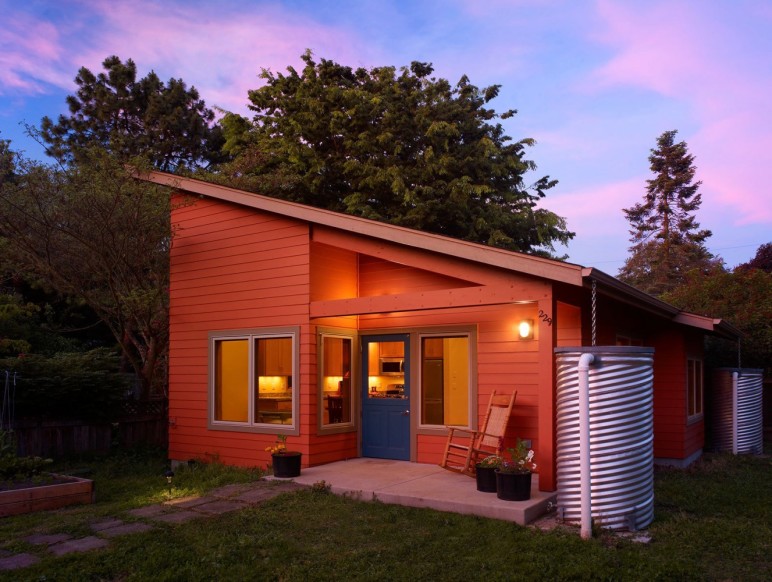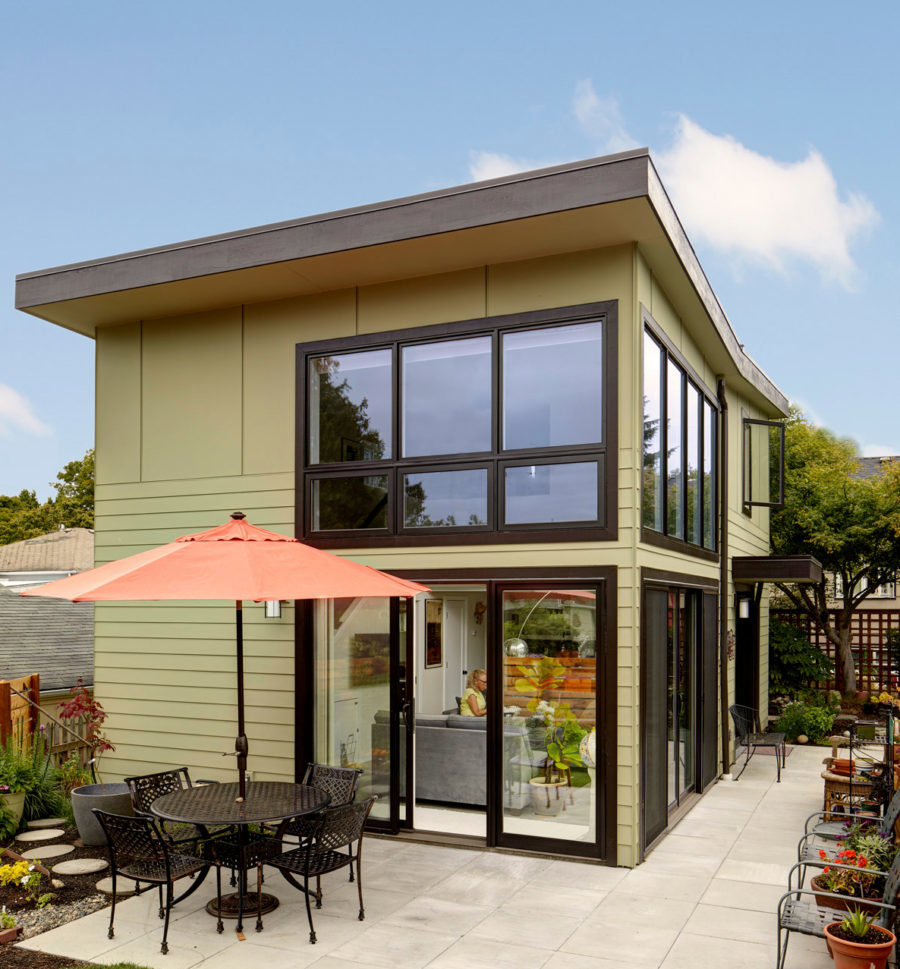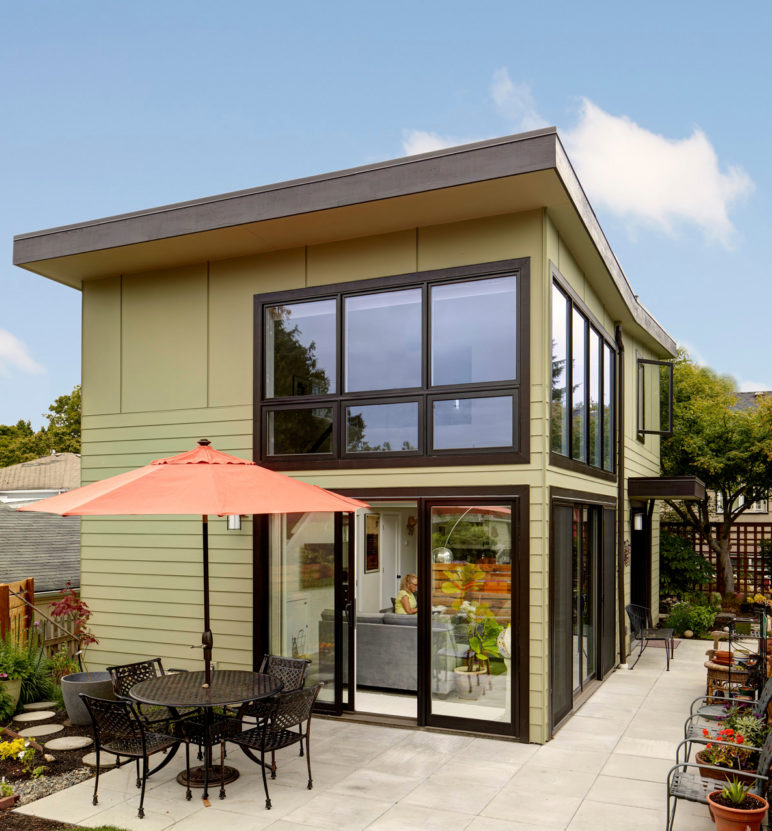Five pilot programs across the United States—including two in Cascadia—are testing the notion that backyard cottages might be a cheaper, and faster complement to more-traditional subsidized apartments.
This is part two in a three article mini-series exploring how accessory dwelling units could help fill the affordable housing gap. You can read part one here.
Part of the solution to housing affordability in booming Cascadian cities could be hidden in plain sight. Could backyard cottages—the darlings of real estate magazines that are mostly built today to house in-laws, adult children, and budding professionals—also offer homes to low-income households currently spending months on waiting lists for subsidized apartments?
At least five pilot programs across the United States—including two in Cascadia—are testing the notion that backyard cottages, also called detached accessory dwelling units (DADUs), might be a cheaper, and faster complement to more-traditional subsidized rental housing. Several other cities are in even earlier planning stages, exploring how this concept could work in their areas. These programs aim to pepper small, affordable homes in leafy neighborhoods that already boast great schools, parks, and transit service. The existing programs have collectively built fewer than 20 little houses so far, but each plans to build more in the coming year and continue to scale up. The challenge will be finding a program model that scales effectively, balancing the costs and unique benefits of cottage housing in a way that makes these mini-homes an attractive subsidized housing option.
One unique advantage of backyard construction projects is that they take a big cost of housing entirely out of the equation: land. Land accounts for 8 to 15 percent of the cost to build subsidized apartments in places with average real-estate prices. It can take an even bigger bite out of the budget in growing, housing-short cities such as Portland and Seattle. Householders who can accommodate backyard cottages already own their yards; they don’t have to buy them again.
That land savings is part of the reason backyard cottage programs may prove cost-competitive with more traditional subsidized apartments. Another is that these programs often rely on public-private partnerships for funding, with individual homeowners frequently paying all or most of the construction cost.
The programs work like this: participating homeowners put in some upfront investment to build their cottage, a blend of time and money that varies by program. They then commit to rent the mini-houses as affordable homes for 5 to 10 years. The definition of affordability varies by program, with some focusing on Section 8 voucher holders or formerly houseless families, and others requiring homeowners to set rents at rates affordable to households with incomes below 50 percent of the area median income (AMI). In exchange, homeowners gain access to benefits ranging from architectural designs, support with permitting and construction, development fee waivers, and in some cases partial construction funding. At the end of their rental commitment, homeowners end up with a backyard cottage all their own.
Austin, Texas; the City of Los Angeles; Los Angeles County; Multnomah County, Oregon; and Seattle are experimenting with different versions of this model, testing blends of participating homeowners’ responsibilities and benefits. Program sponsors vary, from local governments to private non-profits. Each program’s objective is to help fill an affordable housing gap, one that Cascadia has certainly not escaped: Oregon and Washington each have fewer than 53 affordable homes available for every 100 households living on 50 percent of AMI or less.
One challenge the programs face is to induce people to build cottages without simply enriching homeowners already on the winning side of the US housing economy. They must also be competitive in terms of cost and other benefits with more traditional affordable housing development options. The goal is a win-win-win formula in which:
- homeowners benefit from higher property values, a source of rental income, and an opportunity to be part of a solution to the crises of affordable housing and homelessness;
- local jurisdictions get affordable housing that’s cost-effective, and they get it fast; and
- low-income households gain access to more affordable housing choices, often in neighborhoods with higher incomes, good schools, and other public amenities.
All five of these programs are in early or pilot stages, so it’s too soon to tell how well they may scale up. But they represent an intriguing new approach to affordable rental housing, a policy area that needs all kinds of solutions, big and small, to respond to the challenge of housing shortages.
Existing models for using DADUs as subsidized housing

Portland ADU by Rainbow Valley Construction (Used with permission.)
DADU programs for subsidized rental housing vary in the balance of homeowners’ responsibilities and benefits. Multnomah County’s A Place for You represents one end of the spectrum: homeowners take on no up-front financial responsibility. The county, in partnership with a local non-profit and utilizing some outside funding sources, has handled the entire construction and rental process for the program’s existing four cottages. But homeowners also have the most delayed personal benefit from participating in this program; they collect no rent for five years while the new cottages house formerly houseless families in their backyards. At the end of that period homeowners will have the chance to purchase the cottages at a reduced price, though the exact savings for homeowners are still undetermined.
Los Angeles County’s program, still in a planning phase, will place slightly more onus on homeowners than Multnomah’s. Participants will receive partial, not total, funding to build their cottages and enjoy support during permitting and construction. In exchange, they’ll agree to rent their new units to Section 8 voucher holders for 10 years, collecting rent but without full control of the use of their cottage for a decade.
At the other end of the spectrum, programs run by non-profit organizations in the City of Los Angeles and Austin, Texas, put most of the construction and rental management responsibility on homeowners. While homeowners receive modest perks—like access to architectural designs, expedited permitting, and some fee waivers—they cover the entire remaining cost of their cottage development and manage the completed home as a rental unit for Section 8 voucher holders or at a predetermined level of affordability. In exchange for their greater up-front responsibility, homeowners in these programs are able to collect rent, often close to market-rate, from their tenants via the Section 8 program and assume full control over their cottages in five years. Austin’s Alley Flat Initiative has completed eight cottages to date, with nine more in the works; the program in Los Angeles, run by non-profit LA-Más is working to complete its first 10 units this year.
Seattle’s BLOCK Project utilizes a different model entirely. Homeowners volunteer space in their backyards for DADUs out of charity, and receive no personal financial benefit. So far the program has completed one unit, with hopes to complete another in the near future.
How do backyard cottages stack up against typical affordable housing?
Subsidized backyard cottages and more traditional publicly subsidized rental housing each have their benefits and drawbacks. They follow different financing models and timelines and can serve different segments of the population. So comparing the prices of the two isn’t cut and dried: though subsidized DADUs typically have lower total upfront costs, the cost per year of housing depends on each program’s requirements, and the value depends on less quantifiable benefits of each housing type. If subsidized cottage programs are to prove scalable, they’ll need to identify a program model that produces a competitive financing blueprint compared with more traditional subsidized housing development, attractive development timeline, and unique service provision.
Publicly funded affordable housing development hovers around $300,000 per unit…
Building a publicly subsidized affordable rental apartment in the Pacific Northwest costs close to $300,000, according to estimates from Oregon’s Department of Housing and Community Services, and the Washington State Department of Commerce. In Portland, a subsidized rental apartment costs $285,000 on average; in Seattle, where land is more expensive, the city’s Office of Housing estimates subsidized apartments run closer to $340,000 each. Projects in smaller Cascadian towns tend to be cheaper, closer to $225,000 per new dwelling. City or local governments typically pay only a portion of the total cost per unit, with state, federal, and other funding sources covering the rest.
Paradoxically, building subsidized affordable housing tends to cost slightly more per unit than market-rate housing, though in some cases it can cost less per square foot.
The high cost of affordable housing stems from several factors, including higher wage standards for construction workers and contractors working on publicly funded affordable housing; the extra administrative and fundraising expenses involved in navigating the maze of federal, state, local, and charitable subsidy programs that typically pay for such projects; and the fact that many subsidized projects include larger apartments—for families with children—than do most commercial projects.
…while a backyard cottage’s price tag is half that or less
Average DADU development cost in Cascadia ranges from $90,000 to around $160,000, depending on the structure’s size and quality and the vagaries of local construction markets and development fees. In Seattle’s hot market, backyard cottage prices can edge closer to $200,000 or more.
The $70,000 to $150,000 price range per cottage in affordable programs represents a big upfront savings compared with the $300,000 price tag for more traditionally subsidized apartments.
DADUs in subsidized programs cost less than market-rate DADUs, from $70,000 to $150,000 per unit. All of the programs shave costs by using standard architecture plans to streamline construction; several also engage specialized contractors with experience building the predesigned units on a set budget. (Along the same lines, the City of Seattle recently proposed creating its own set of pre-approved designs for backyard cottages and giving them away to resident homeowners interested in building DADUs.) Some programs are also experimenting with off-site modular construction to cut cost and speed construction. Finally, several of these programs operate in housing markets with lower labor and materials costs than those in Cascadia’s largest cities, further reducing expenses compared with Cascadian averages.
The $70,000 to $150,000 price range per cottage in affordable programs represents a big upfront savings compared with the $300,000 price tag for more traditionally subsidized apartments. One reason is that DADUs sidestep the cost of land, which can account for 8 to 15 percent or more of a housing project budget. DADUs, of course, are built on underutilized single-family lots and thus have no land costs. Other reasons for the lower cost of DADUs compared with other subsidized rental housing include smaller unit size, dedicated funding streams for the projects that eliminate the need—and expense—of chasing complicated funding packages, shorter construction timelines, and fewer amenities than subsidized buildings, which often contain public space or access to on-site social services.
In Austin and Los Angeles, where private homeowners cover most or all of construction costs, public subsidy per home is particularly small compared with more traditional subsidized affordable housing development. The drawback of this arrangement is that it rules out participation for homeowners without the financial resources to fund cottage construction.
LA-Más, the non-profit managing the program in the City of Los Angeles, is working directly with Self-Help Federal Credit Union to make its program accessible to low-income homeowners. The credit union is testing a new mortgage product specifically for backyard cottage development that requires an upfront investment of $3,500. The credit union is rolling out the new mortgages this year, so it’s too soon to say whether they’ll be successful, but they represent a promising solution to this equity concern.
Cost comparisons aren’t cut and dry
Though up-front costs are higher, standard subsidized housing usually serves low-income tenants for longer than will subsidized DADUs. Traditional subsidized housing remains affordable for 40 years or more, translating to a development cost of $7,500 per year for a $300,000 apartment.
The new DADU programs promise affordability for only 5 to 10 years, but public development cost per year is difficult to estimate. Most are in pilot stages, still determining their budgets, and vary widely in the balance of public versus private funding. It’s also unclear how to price the public cost of some of the benefits homeowners receive, like access to DADU architectural plans, expedited permit review, fee waivers, and staff time in consultations, all of which vary widely by project.
In Los Angeles County’s program, for example, homeowners will receive a $75,000 grant to build a cottage, plus permitting support, in exchange for making their cottages available to Section 8 voucher holders for 10 years. This suggests a public cost of slightly more than $7,500 per year of affordable housing, depending on the value of the permitting support, or slightly less than the cost per affordable housing unit in California, where development is typically more expensive than in Oregon or Washington. But, the city or county’s portion of the total cost of building a new subsidized apartment unit is usually less than half of the total development cost, meaning the program cost to the county per unit could be higher.
The public cost of cottages in Austin’s Alley Flat Initiative is harder to estimate. The city provides participating homeowners with some development and permitting fee waivers, which can range in value from a few hundred dollars to well over $10,000 depending on the project circumstances and level of affordability homeowners commit to. (Homeowners also get free architectural designs plus staff time for project support, but donations to private non-profits largely fund those perks.) In exchange, the city gets five years of guaranteed affordable housing. So the public cost of this program likely hovers around a few thousand dollars per year per unit per year but with wide variation between individual cottages.
Each can provide different forms of tenant support
Traditional subsidized housing can provide on-site access to social support services, something not practical on the small scale of an individual DADU. For example, some buildings provide permanent supportive housing services for formerly houseless individuals at high risk of experiencing housing instability again. This wraparound support is highly effective at reducing new episodes of homelessness, and can even cut social service spending through improved tenant health and other outcomes.
Though similar on-site support probably isn’t possible for individual cottages, many of the new DADU programs require that participating homeowners live near transit or social service sites. DADU housing can provide other benefits to tenants, too, including privacy and access to neighborhood amenities often concentrated in single-family zones, such as top schools and green spaces.
DADUs are quicker to build
Several of the pilot cottage programs cite speed of construction as another benefit of cottages over traditional subsidized rental housing: backyard mini home programs can increase the supply of affordable housing available in a matter of months, rather than the years larger subsidized construction projects usually go through.
A manager from Multnomah County’s A Place for You pilot program estimated that a DADU can go from breaking ground to move-in ready in 90 days, though that doesn’t account for the time it took to secure program funding or iron out new contracts and legal concerns associated with this never before tried arrangement. Programs that expedite permitting for pre-approved DADU designs, or utilize modular construction, could trim timelines even further. Of course, high-end, custom cottages have much longer construction timelines, but most subsidized programs aim to streamline development as much as possible.
At this early stage, it’s difficult to say how this promise will bear out. It will be highly dependent on how easily funding comes together. Also, though individual cottages may be faster to construct than entire subsidized apartment buildings, that alone won’t help increase affordable housing options much unless the programs can successfully scale up to produce hundreds of units.
On balance, subsidized DADUs have smaller up-front costs compared with standard subsidized apartments, offer some unique benefits to tenants such as additional privacy or potential access to high opportunity neighborhoods, and may have shorter construction timelines. Traditional subsidized housing development, on the other hand, can offer more standard tenant support services, and could be price-competitive with DADUs, depending on a program’s financing package. The newness of subsidized DADU programs also brings with it some additional challenges, like determining new legal arrangements and contractual relationships between private homeowners, local jurisdictions, and non-profits. These hurdles will get easier with time as more programs experiment with these arrangements, but for now represent an additional challenge with subsidized cottage programs.
Backyard cottages could be an innovative new type of affordable housing
It’s too soon to tell whether any of these subsidized cottage schemes can be scaled up to cost-effectively create an impactful number of affordable homes. Each is testing out a unique formula, balancing different financing models, timelines, and other benefits. Nonetheless, the appearance of like-minded efforts in several locations indicate many believe the potential is real. Other cities, including Denver, the city of Seattle, and a new socially responsible impact investment model in Seattle, are also in early stages of exploring similar subsidized accessory dwelling unit programs. As the affordable housing gap continues to grow in the United States, subsidized backyard cottages could become another tool in the kit for providing affordable housing. In my next article I’ll examine a few other subsidized DADU program models that focus on supporting vulnerable homeowners avoid foreclosure.
Reducing policy barriers to building backyard cottages could be one way to support these programs. The fewer hoops homeowners have to jump through to build a backyard cottage, the less the expense and the higher the likelihood that programs like these can find cost-effective formulas for scaling up.
Notes:
Data on average cost of subsidized housing in Cascadia are based on communication with staff members of the City of Seattle Office of Housing, Oregon Housing and Community Services, and Washington State Department of Commerce.
Data on average development cost for backyard cottages are also based on communication with researchers for 2018 Institute for Sustainable Solutions survey.
Thank you to staff from Los Angeles and Multnomah Counties, and non-profit organizations the Alley Flat Initiative, LA-Más, and the Seattle BLOCK Project for filling in and verifying details about each of the subsidized DADU programs in this article. And thanks to Nisma Gabobe for her research help with this article.












Matt hutchins
Considering many AdUs are rented at below market or even free to friends and family, ‘voluntary affordability’ is a big share of market —usually about 20-25% of households where there is data (portland, Edmonton, Vancouver). If we had an official program that produced 25% affordable units, people would be crowing about its success!
Neil
I think this is an idea where Seattle should change zoning, reduce regulatory burden, then get out of the way. The problem is traditional single family neighborhoods are scared of renters and the “rent is too damn high” folks hate it when there is a profit motive.
Charlie
There may be a cost to upgrade sewers and other infrastructure. If a significant number of backyard dwellings were built to accommodate families with children, there needs to be a a good accessible school system in place with room.
In addition, backyard dwellings may result in more parked cars. People may also build the backyard dwellings and turn them into Airbnbs, which may be less regulated and can have a higher rate of return.
I am curious about how many homeowners would actually rent to a section 8 family?
Jeff Smith
Please learn about places with plenty of supply–lots of empty homes–and unaffordable housing. Please learn about places with tons of vacant lots and abandoned buildings. Please learn about places that have corrected such “anomalies” by shifting the property tax off buildings, onto land. Please learn about land speculation, land hoarding, how both banks and governments support our dark heritage. To the extent you succeed in dealing with symptom, you’ll only make things worse. Every improvement any time anywhere eventually pushes up location value. Location is what’s not affordable, not any sort of building. Whatever it takes to open the mind to how owners see the world, please find it–integrity in research, in writing, whatever. Sure, our brains need whitewashing, but at times we also need to hear truth. This is one of those times.
randy
Where are these places? The only one I can think of is Miami, though there must be others. Please tell..
Ardith
This sounds like a viable option. Only one possible drawback might be if the tenants carry a culture of poverty with them as described by John F. Kennedy years ago in his book. Where people wrecked the units they were given.
Max Atwood
If you are looking to build an ADU in Austin, Texas check out Austin ADU Builders